
Expressionism - III
Oskar Kokoschka
1886 - 1980

Oskar Kokoschka
1910
Oskar Kokoschka
(b Pöchlarn, Lower Austria, 1 March 1886; d Montreux, 22 Feb 1980).
Austrian painter, printmaker and writer. He revolutionized the art of the turn of the century, adopting a radical approach to art, which was for him essential to the human condition and politically engaged. Kokoschka promoted a new visual effect in painting, related to making visible the immaterial forces active behind the external appearance of things, in which the object was a living, moving substance that revealed its inner essence to the eye. This applied to the portraits as well as to the townscapes. The art-historical basis for his work lies in the painting tradition of Austrian late Baroque and especially in the colourfully expressive visions of Franz Anton Maulbertsch. As was true of many artists of his generation, Kokoschka’s creative urge was also expressed in literature and showed a clear inclination towards music and theatre.

Alma Maria Mahler Gropius Werfel (born Alma Margaretha Maria Schindler; 31 August 1879 – 11 December 1964) was an Austrian composer, author, editor, and socialite. At 15, she was mentored by Max Burckhard. Musically active from her early years, she was the composer of nearly fifty songs for voice and piano, and works in other genres as well. Only 17 songs are known to survive.
In her early years, she had an affair with composer and conductor Alexander von Zemlinsky, but their relationship did not last long. She became the wife of composer Gustav Mahler, who was not interested in her compositions. Eventually she fell into depression from being artistically stifled. While her marriage was struggling, she had an affair with Walter Gropius. Gustav started to encourage Alma's composing and helped prepare some of her compositions for publication, but died soon after this attempted reconciliation in 1911. Alma married Gropius in 1915 and the couple had a daughter together, Manon Gropius. During her marriage to Gropius, Alma had an affair with Franz Werfel. Alma and Werfel were eventually married after Alma separated from Gropius.
In 1938, after the Anschluss, Werfel and Alma were forced to flee Austria, as it was unsafe for Jews. Eventually the couple settled in Los Angeles. In later years, her salon became part of the artistic scene, first in Vienna, then in Los Angeles and in New York.
Alma Mahler
1909
The Bizarre Story of Oskar Kokoschka and His Alma Mahler Doll
Alma Mahler (1879–1964) was a Viennese socialite and arts patron whose infamous romantic life inspired composers, painters, and novelists, including Gustav Mahler, Walter Gropius, Franz Werfel, and others. Between her marriages to Mahler (who died in 1911) and Gropius (in 1915), Alma had a turbulent affair with the expressionist painter Oskar Kokoschka (1886–1980), who memorialized her in his painting The Bride of the Wind, 1913-14 (just before their relationship ended).
Unable to forget his muse and lover, in July 1918 Kokoschka ordered a life-size doll from the Munich doll-maker Hermine Moos as a substitute for his lost love. It was to be made to look exactly like Alma Mahler.
On July 22 he already returned a model of the head, having checked it and made suggestions as to how the work should proceed. “If you are able to carry out this task as I would wish, to deceive me with such magic that when I see it and touch it imagine that I have the woman of my dreams in front of me, then dear Fräulein Moos, I will be eternally indebted to your skills of invention and your womanly sensitivity as you may already have deduced from the discussion we had.”

Hermine Moos working on the faux Alma Mahler.
Kokoschka provided Moos with many detailed drawings and a life sized oil sketch. On August 20, 1918 he wrote to Moos: “Yesterday I sent a life-size drawing of my beloved and I ask you to copy this most carefully and to transform it into reality. Pay special attention to the dimensions of the head and neck, to the ribcage, the rump and the limbs. And take to heart the contours of body, e.g., the line of the neck to the back, the curve of the belly. Please permit my sense of touch to take pleasure in those places where layers of fat or muscle suddenly give way to a sinewy covering of skin. For the first layer (inside) please use fine, curly horsehair; you must buy an old sofa or something similar; have the horsehair disinfected. Then, over that, a layer of pouches stuffed with down, cottonwool for the seat and breasts. The point of all this for me is an experience which I must be able to embrace!”

Kokoschka’s letter to Hermine Moos.
In December Kokoschka eagerly demanded of Hermine Moos: “Can the mouth be opened? Are there teeth and a tongue inside? I hope.”
The doll was not finished until the second half of February 1919. On February 22 Kokoschka asked to have the doll sent to him. The packing-case arrived. Kokoschka writes: “In a state of feverish anticipation, like Orpheus calling Eurydice back from the Underworld, I freed the effigy of Alma Mahler from its packing. As I lifted it into the light of day, the image of her I had preserved in my memory stirred into life.”

Kokoschka Alma Mahler doll (1919)
He got his servant to spread rumors about the doll, to give the public impression that she was a real woman, for example, that he had hired a horse and carriage to take her out on sunny days, and rented a box for her at the Opera in order to show her off.
Kokoschka was ultimately disappointed with the result, a clumsy construction of fabric and wood wool. He complained that the shag carpet-like skin was not life-like enough. Despite the doll’s shortcomings, she turned out to be a compliant substitute companion and muse. The live Alma Mahler long gone, Kokoschka started a series of paintings of the doll.
.jpg)
Kokoschka Alma Mahler doll (1919)
After several moths, despite Kokoschka’s effort, expense and energy, he decided to dispense with the fetish. “I engaged a chamber orchestra from the Opera. The musicians, in formal dress, played in the garden, seated in a Baroque fountain whose waters cooled the warm evening air. A Venetian courtesan, famed for her beauty and wearing a very low-necked dress, insisted on seeing the Silent Woman face to face, supposing her to be a rival. She must have felt like a cat trying to catch a butterfly through a window-pane; she simply could not understand. Reserl paraded the doll as if at a fashion show; the courtesan asked whether I slept with the doll, and whether it looked like anyone I had been in love with... In the course of the Party the doll lost its head and was doused in red wine. We were all drunk.”
The next day, a police patrol happened to glance through the gates, and seeing what was apparently the body of a naked woman covered with blood, they burst into the house suspecting some crime of passion. And for that matter, that’s what it was... “because in that night I had killed Alma...”

OSKAR KOKOSCHKA:
Self-portrait with Doll. 1922. Berlin.
Staatliches Museum

Bride of the wind
Oskar Kokoschka. 1914

Alma Mahler by Oskar Kokoschka, 1912

Oskar Kokoschka
Mädchen mit Tonpuppe, 1922

Self-portrait with Doll. 1922.
Oskar Kokoschka

Oskar Kokoschka and Alma Mahler, c.1912-1913
by Oskar Kokoschka

Two Nudes, Lovers, Oskar Kokoschka, 1913

Lovers, Oskar Kokoschka and Alma Mahler 1913

Oskar Kokoschka
Olda Palkovskà
1937

The Pagans
Oskar Kokoschka
1915

Oskar Kokoschka. Mother and Child. 1921

Oskar Kokoschka. Summer. 1922

Oskar Kokoschka. Girl with Flowers. 1932
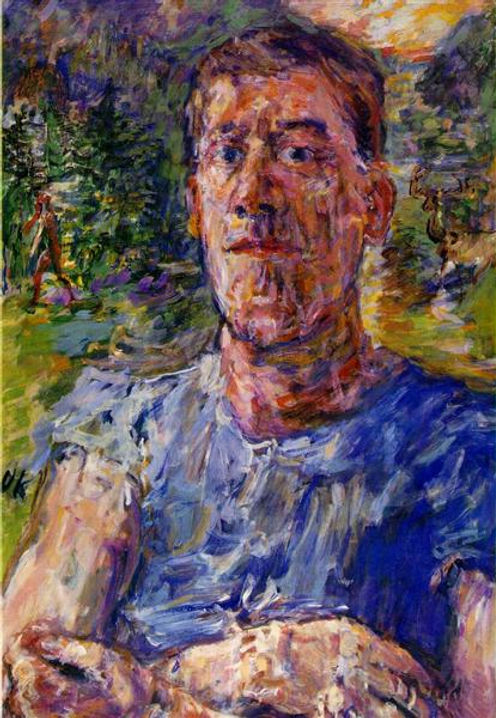
Self-portrait of a 'Degenerate Artist'
Oskar Kokoschka
Date: 1937

OSKAR KOKOSCHKA:
THE RED EGG AND THE PARTITION OF EUROPE. 1940-1941. Private Collection

Oskar Kokoschka. Loreley. 1941/42

Oskar Kokoschka. Anschluß - Alice in Wonderland. 1941/42

The Rejected Lover
Oskar Kokoschka
1966
August Macke
1887 –1914

August Robert Ludwig Macke (3 January 1887 – 26 September 1914) was a German Expressionist painter. He was one of the leading members of the German Expressionist group Der Blaue Reiter (The Blue Rider). He lived during a particularly active time for German art: he saw the development of the main German Expressionist movements as well as the arrival of the successive avant-garde movements which were forming in the rest of Europe. As an artist of his time, Macke knew how to integrate into his painting the elements of the avant-garde which most interested him. Like his friend Franz Marc and Otto Soltau, he was one of the young German artists who died in the First World War.
August Macke

August Macke. Staudacher's house at the Tegernsee, 1910
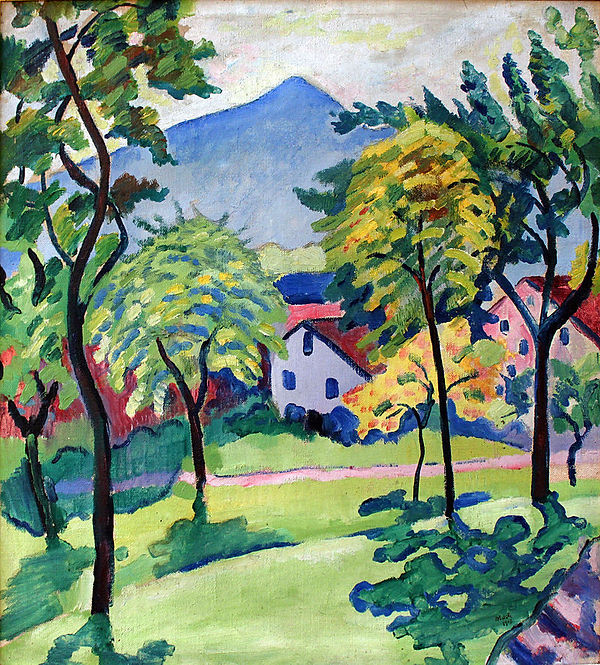
August Macke. Tegernsee landscape, 1910
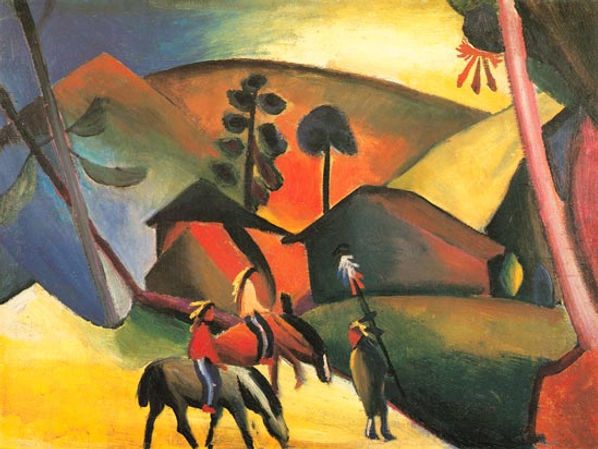
August Macke. Indians on Horseback, 1911

August Macke. Rokoko,1912

August Macke. Two girls, 1913

August Macke. Promenade, 1913

August Macke. Lady in a Green Jacket, 1913

August Macke. Kairouan (III), 1914

August Macke. Red house in the park, 1914
Egon Schiele
1890 – 1918

Egon Leo Adolf Ludwig Schiele (12 June 1890 – 31 October 1918) was an Austrian Expressionist painter. His work is noted for its intensity and its raw sexuality, and for the many self-portraits the artist produced, including nude self-portraits. The twisted body shapes and the expressive line that characterize Schiele's paintings and drawings mark the artist as an early exponent of Expressionism. Gustav Klimt, a figurative painter of the early 20th century, was a mentor to Schiele.

EGON SCHIELE

EGON SCHIELE:
Pair embracing, 1917

EGON SCHIELE

EGON SCHIELE

EGON SCHIELE

EGON SCHIELE

EGON SCHIELE

EGON SCHIELE

EGON SCHIELE

EGON SCHIELE

EGON SCHIELE

EGON SCHIELE

EGON SCHIELE

EGON SCHIELE

EGON SCHIELE

EGON SCHIELE
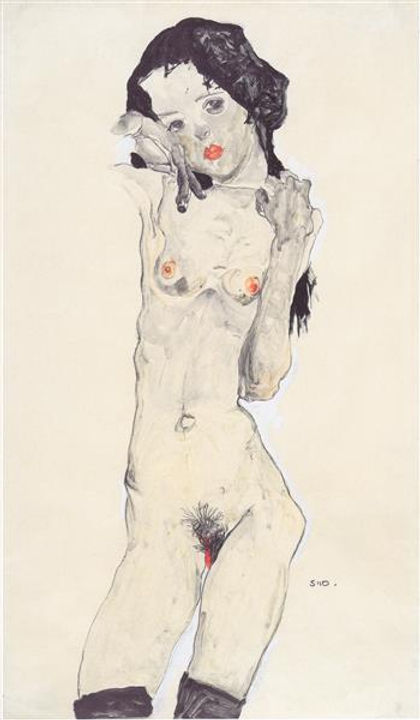
EGON SCHIELE

EGON SCHIELE

EGON SCHIELE

EGON SCHIELE

EGON SCHIELE

EGON SCHIELE

EGON SCHIELE

EGON SCHIELE

EGON SCHIELE

EGON SCHIELE

EGON SCHIELE

EGON SCHIELE

EGON SCHIELE

EGON SCHIELE

EGON SCHIELE

EGON SCHIELE

EGON SCHIELE

EGON SCHIELE
Self-portraits


* * *


* * *

* * *


* * *

* * *

* * *
.jpg)
Lovers – Self-Portrait with Wally, c. 1914 – 1915
Jeanne Mammen
1890 – 1976

Jeanne Mammen
(21 November 1890 – 22 April 1976) was a German painter, illustrator, and printmaker. Her work is associated with the New Objectivity, Symbolism, and Cubism movements. She is best known for her depictions of strong, sensual women and Berlin city life during the Weimar period.
Jeanne Mammen was born in Berlin, the daughter of a successful German merchant. She studied art in Paris, Brussels and Rome from 1906-1911. Her early work, influenced by Symbolism, Art Nouveau, and the Decadent movement, was exhibited in Brussels and Paris in 1912 and 1913.
She was now financially on her own for the first time, as the French government had confiscated all of her family's property. For several years Mammen struggled to make ends meet, taking any work she could find, and spending time with people from different class backgrounds. These experiences and newfound sympathies are reflected in her artwork from the period.
In time Mammen was able to find work as a commercial artist, producing fashion plates, movie posters, and caricatures for satirical journals such as Simplicissimus, Ulk, and Jugend. In the mid-1920s she became known for her illustrations evoking the urban atmosphere of Berlin. Much of her artwork depicted women. These women subjects often included haughty socialites, fashionable middle-class shop girls, street singers, and prostitutes.Her drawings were often compared to those of George Grosz and Otto Dix.
In 1930 she had a major exhibition in the Fritz Gurlitt gallery. Over the next two years, at Gurlitt's suggestion, she created a series of eight lithographs illustrating Les Chansons de Bilitis, a collection of lesbian love poems by Pierre Louÿs.
In 1933, following Mammen's inclusion in an exhibition of female artists in Berlin, the Nazi authorities denounced her motifs and subjects as "Jewish", and banned her lithographs for Les Chansons de Bilitis. The Nazis were also opposed to her blatant disregard to for apparent 'appropriate' female submissiveness in her expressions of her subjects. Much of her work also includes imagery of lesbians. The Nazis shut down most of the journals she had worked for, and she refused to work for those that complied with their cultural policies.
In the 1940s, in a show of solidarity, Mammen began experimenting with Cubism and expressionism, a risky move given the Nazis' condemnation of abstract art as "degenerate". After the war she took to collecting wires, string, and other materials from the streets of bombed-out Berlin to create reliefs. In the late 1940s she began exhibiting her work again, as well as designing sets for the Die Badewanne cabaret. She created abstract collages from various materials, including candy wrappers. In the 1950s she adopted a new style, combining thick layers of oil paint with a few fine marks on the surface.
In the 1970s there was a resurgence of interest in Mammen's early work as German art historians, as well as art historians of the women's movement, rediscovered her paintings and illustrations from the Weimar period.

Jeanne Mammen. Self Purtrait

Jeanne Mammen.

Jeanne Mammen.

Jeanne Mammen.

Jeanne Mammen.

Jeanne Mammen.

Jeanne Mammen.

Jeanne Mammen.
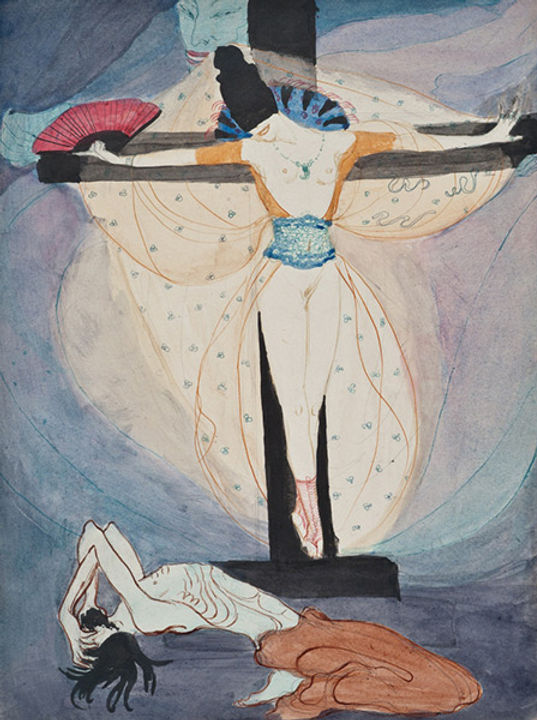
Jeanne Mammen.

Jeanne Mammen.

Jeanne Mammen.

Jeanne Mammen.
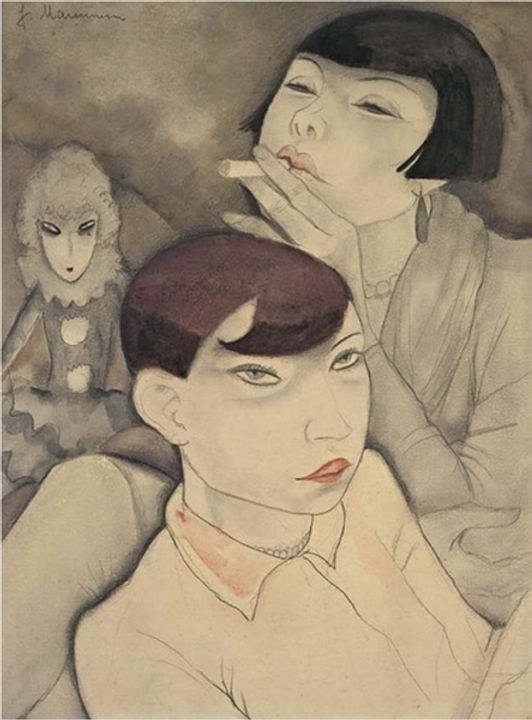
Jeanne Mammen.

Jeanne Mammen.

Jeanne Mammen.

Jeanne Mammen.

Jeanne Mammen.

Jeanne Mammen.

Jeanne Mammen.

Jeanne Mammen.
Otto Dix
1891 – 1969
Wilhelm Heinrich Otto Dix (2 December 1891 – 25 July 1969) was a German painter and printmaker, noted for his ruthless and harshly realistic depictions of German society during the Weimar Republic and the brutality of war. Along with George Grosz and Max Beckmann, he is widely considered one of the most important artists of the Neue Sachlichkeit.
Otto Dix was born in Untermhaus, Germany, now a part of the city of Gera, Thuringia. The eldest son of Franz Dix, an iron foundry worker, and Louise, a seamstress who had written poetry in her youth, he was exposed to art from an early age. The hours he spent in the studio of his cousin, Fritz Amann, who was a painter, were decisive in forming young Otto's ambition to be an artist; he received additional encouragement from his primary school teacher. Between 1906 and 1910, he served an apprenticeship with painter Carl Senff, and began painting his first landscapes. In 1910, he entered the Kunstgewerbeschule in Dresden, now the Dresden Academy of Fine Arts, where Richard Guhr was among his teachers. At that time the school was not a school for the fine arts but rather an academy that concentrated on applied arts and crafts.
The majority of Dix's early works concentrated on landscapes and portraits which were done in a stylized realism that later shifted to expressionism.

Self-Portrait
Otto Dix
1914

Dream of the sadist
Otto Dix
1913

Moon Woman
Otto Dix1919

Match seller
Otto Dix
1920

Otto Dix. Triptych of War
1929-32

The Trench by Otto Dix (1923)

Otto Dix, Stormtroops Advancing Under a Gas Attack (c. 1920)

Otto Dix, Schädel (Skull), 1924

Otto Dix, War Cripples (1920)

Three Prostitutes on the Street
Otto Dix
1925

The Uneven Couple, Otto Dix, 1925

Otto Dix. Old Couple, 1923

Otto Dix, Metropolis (1928)

Otto Dix, Melancholy (1930)

The Salon I by Otto Dix (1921)

Otto Dix, Portrait of Dancer Anita Berber (1925)

Two Children, 1921 by Otto Dix

Dr. Hans Koch, the Dermatologist and Urologist
1921

Lot and His Daughters — by Otto Dix

The Temptation of St. Anthony by Otto Dix

The Temptation of St. Anthony by Otto Dix
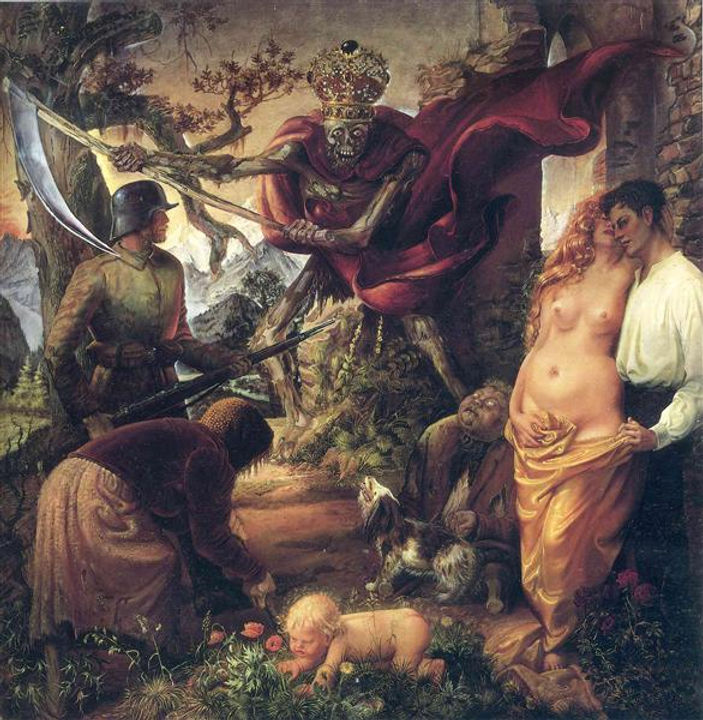
The Triumph of Death
Otto Dix

"Vanitas (Youth and Old Age)"
Otto Dix - 1932

Portrait of the journalist Sylvia von Harden by Otto Dix

Otto Dix. Dr. Hans Koch, the Dermatologist and Urologist
1921
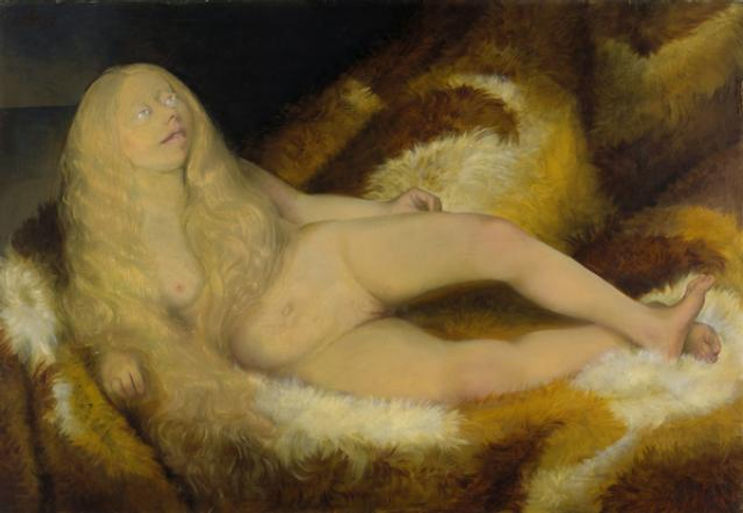
Otto Dix Mädchen auf Fell [Nude Girl on a Fur] 1932

Otto Dix Untitled

Ellis — Otto Dix

Otto Dix's "Half-Nude", 1926.

Otto Dix Rothaarige Frau

Reclining Woman on a Leopard Skin-1927 by Otto Dix

Otto Dix - Girl at the Mirror (1921

Three Wenches
Otto Dix
.jpg)
Otto Dix: Self-Portrait with Nude Model

Otto Dix: Self-Portrait with Nude Model
Karl Hubbuch
1891 – 1979
Karl Hubbuch
(21 November 1891 – 26 December 1979) was a German painter, printmaker, and draftsman associated with the New Objectivity.
Hubbuch was born in Karlsruhe and baptised in the Roman Catholic church. From 1908 to 1912, he studied art at the Karlsruhe Academy, where he formed friendships with fellow students Georg Scholz and Rudolf Schlichter. He continued his studies with Emil Orlik at the Berlin Museum of Arts and Crafts School until the First World War. From 1914 to 1918 he served in the military, where he contracted malaria. He spent the period after the war recuperating before resuming his studies in a master class at the Karlsruhe Academy. In 1924, Hubbuch was given a position as an assistant lithography instructor at the Karlsruhe Academy. He became the head of the drawing department the following year, and in 1928 he was appointed professor.
During this period, Hubbuch was much more active as a draftsman than as a painter. His drawings and prints of the early 1920s, sharply realistic in style, are highly critical of the social and economic order. A trip to Berlin in 1922—during which he met George Grosz—inspired the creation of several drawings in which Hubbuch depicted himself as an observer who reacts to the urban dynamism surrounding him. He exhibited several drawings and prints, as well as his oil painting, The Classroom, in the seminal "Neue Sachlichkeit' ("New Objectivity") exhibition at the Kunsthalle in Mannheim in 1925.
On 4 January 1928 he married Hilde (née Isay; 1905–1971) in Trier, where she was born and raised, and who had studied photography at the Bauhaus. Her likeness is recognizable in many of Hubbuch's works of the 1920s, such as Zweimal Hilde ("Hilde Twice"), painted in 1923. Hubbuch published collections of satirical drawings, and in 1930 he collaborated with Erwin Spuler and Anton Weber in publishing the critical and satirical magazine "Zakpo". As a known antifascist, Hubbuch was dismissed in 1933 from his teaching position and forbidden to paint by the Nazi authorities. Having an affair before, Hubbuch got divorced in 1933, and Hilde, being Jewish, emigrated in the same year to Vienna (till 1938) and on via London to New York, where, varying the name to Hubbuck, she made a career as a photographer. In 1940 he married Ellen Heid (née Adam-Falk), who had her daughter Myriam (b. 1932) before they met. Until 1945 he supported himself with commercial jobs which included decorating ceramics and painting clock faces.
After the war he was able to resume his post as a professor of painting at the Karlsruhe Academy of Fine Arts, where he would teach until 1957. He worked in relative obscurity during this later period, painting and drawing in a style close to expressionism. In the 1960s the revival of interest in figurative art brought new attention to his work, along with a reevaluation of the artists of the New Objectivity in general.
Because of failing eyesight he produced few works after 1970. Karl Hubbuch died in 1979 in Karlsruhe, where approximately 100 of his works are now housed in Gochsheim Castle.

Karl Hubbuch

Karl Hubbuch

Karl Hubbuch

Karl Hubbuch

Karl Hubbuch

Karl Hubbuch

Karl Hubbuch

Karl Hubbuch

Karl Hubbuch

Karl Hubbuch

Karl Hubbuch

Karl Hubbuch

Karl Hubbuch

Karl Hubbuch

Karl Hubbuch

Karl Hubbuch

Karl Hubbuch

Karl Hubbuch

Karl Hubbuch

Karl Hubbuch
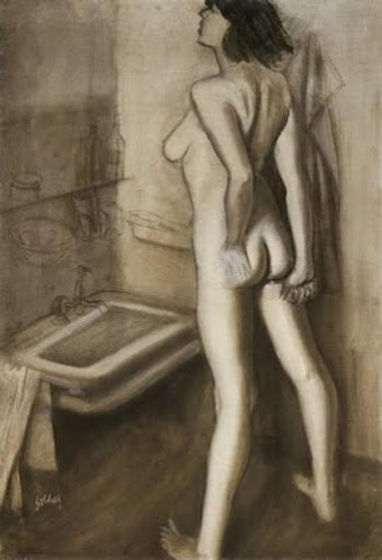
Karl Hubbuch

Karl Hubbuch

Karl Hubbuch

Karl Hubbuch

Karl Hubbuch

Karl Hubbuch

Karl Hubbuch

Karl Hubbuch

Karl Hubbuch
George Grosz
1893 – 1959

George Grosz ( July 26, 1893 – July 6, 1959) was a German artist known especially for his caricatural drawings and paintings of Berlin life in the 1920s. He was a prominent member of the Berlin Dada and New Objectivity groups during the Weimar Republic. He emigrated to the United States in 1933, and became a naturalized citizen in 1938. Abandoning the style and subject matter of his earlier work, he exhibited regularly and taught for many years at the Art Students League of New York. In 1959 he returned to Berlin, where he died shortly afterwards.
Grosz was born Georg Ehrenfried Groß in Berlin, Germany, the third child of a pub owner. His parents were devoutly Lutheran. Grosz grew up in the Pomeranian town of Stolp (now Słupsk, Poland). After his father's death in 1900, he moved to the Wedding district of Berlin with his mother and sisters. At the urging of his cousin, the young Grosz began attending a weekly drawing class taught by a local painter named Grot. Grosz developed his skills further by drawing meticulous copies of the drinking scenes of Eduard von Grützner, and by drawing imaginary battle scenes. He was expelled from school in 1908 for insubordination.
George Grosz in 1921

George Grosz, Daum marries her pedantic automaton George in May 1920

George Grosz, Republican Automatons, 1920

"Café 1"
George Grosz

"The Eclipse of the Sun" 1926
George Grosz

"The Agitator"
George Grosz - 1928

"Explosion"
George Grosz - 1917

"Germany a Winter's Tale"
George Grosz - 1919

"street scene"
George Grosz

"Twilight"
George Grosz - 1922

Sonniges Land
George Grosz

Passersby 1926 Estate of George Grosz

Ecce Homo (1923)
George Grosz

Ecce Homo (1923)
George Grosz

Ecce Homo (1923)
George Grosz

Ecce Homo (1923)
George Grosz

Ecce Homo (1923)
George Grosz

Ecce Homo (1923)
George Grosz

Die Gten Jahre
George Grosz

Gray day
George Grosz

The Wanderer
George Grosz

Das Ende des Weges
George Grosz

Whisky
George Grosz
Francis Bacon
1909 – 1992

Self-Portrait Francis Bacon
Francis Bacon (28 October 1909 – 28 April 1992) was an Irish-born British figurative painter known for his raw, unsettling imagery. Focusing on the human form, his subjects included crucifixions, portraits of popes, self-portraits, and portraits of close friends, with abstracted figures sometimes isolated in geometrical structures. Rejecting various classifications of his work, Bacon said he strove to render "the brutality of fact." He built up a reputation as one of the giants of contemporary art with his unique style.
Bacon said that he saw images "in series", and his work, which numbers in the region of 590 extant paintings along with many others he destroyed, typically focused on a single subject for sustained periods, often in triptych or diptych formats. His output can be broadly described as sequences or variations on single motifs; including the 1930s Picasso-influenced bio-morphs and Furies, the 1940s male heads isolated in rooms or geometric structures, the 1950s "screaming popes," the mid-to-late 1950s animals and lone figures, the early 1960s crucifixions, the mid-to-late 1960s portraits of friends, the 1970s self-portraits, and the cooler, more technical 1980s paintings.

Crucifixion
Francis Bacon
1933

Fury
Francis Bacon
1944

Three Studies for Figures at the Base of a Crucifixion
Francis Bacon
1944

Painting
Francis Bacon
1946

Head VI
Francis Bacon
1949
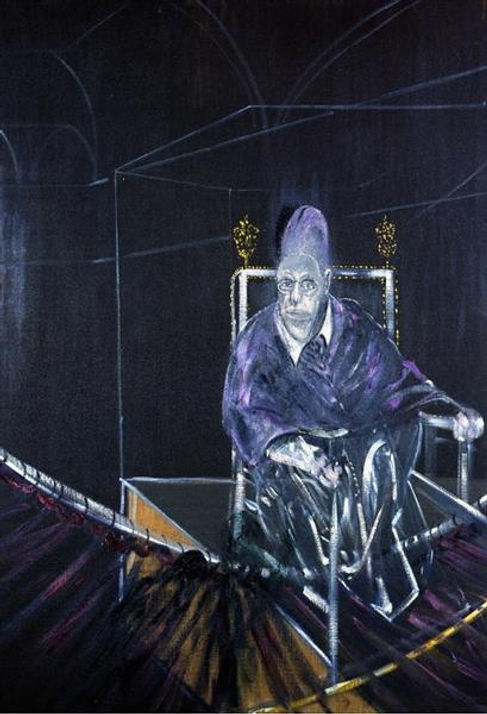
Pope I
Francis Bacon
1951

Portrait of Lucian Freud
Francis Bacon
1951

Crouching Nude
Francis Bacon
c.1952
_jpg!Large.jpg)
Two Figures
Francis Bacon
1953

Study after Velazquez's portrait of Pope Innocent X
Francis Bacon
1953

Figure with Meat
Francis Bacon
1954
.jpg)
William Blake
Francis Bacon
1955

MLLE SUZY SOLIDOR
Francis Bacon
1957

Lying Figure No.1
Francis Bacon
1959

Sleeping Figure
Francis Bacon
1959
.jpg)
Woman IV
Francis Bacon
1960

Homage to Van Gogh
Francis Bacon
1960

Three Studies for a Crucifixion
Francis Bacon
1962
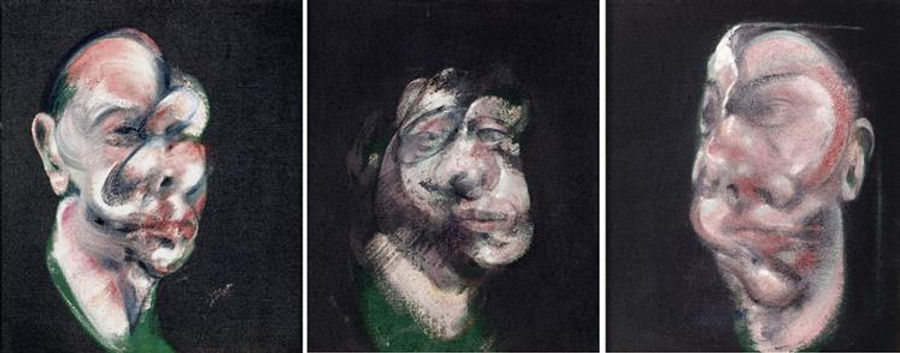
Study for Three Heads
Francis Bacon
1962

Study of Red Pope
Francis Bacon
1962

Three Studies for Portrait of Henrietta Moraes
Francis Bacon
1963

Lying Figure with Hypodermic Syringe
Francis Bacon
1963

Figure on a folding bed
Francis Bacon
1963

Portrait of Henrietta Moraes
Francis Bacon
1963

Crucifixion
Francis Bacon
1965

Three Studies for Portrait of George Dyer (on pink ground)
Francis Bacon
1964

Three Studies for Portrait of George Dyer (on light ground)
Francis Bacon
1964

Double Portrait of Lucian Freud and Frank Auerbach
Francis Bacon
1964

After Muybridge - Study of the Human Figure in Motion - Woman Emptying a Bowl of Water and Paralytic Child on all Fours
Francis Bacon
1965

Portrait of Lucian Freud
Francis Bacon
1965
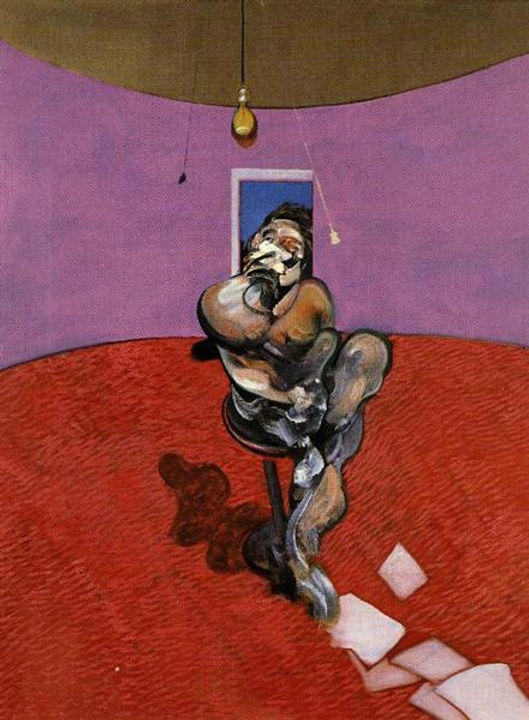
Portrait of George Dyer Talking
Francis Bacon
1966

Lying Figure
Francis Bacon
1966

Portrait of Isabel Rawsthorne
Francis Bacon
1966

Henrietta Moraes
Francis Bacon
1966

Study for Head of Isabel Rawsthorne
Francis Bacon
1967

Portrait of Isabel Rawsthorn standing in a street in soho
Francis Bacon
1967

Two Figures Lying on a Bed with Attendants
Francis Bacon
1968

Study for a Nude with Figure in a Mirror
Francis Bacon
1969

Lying Figure
Francis Bacon
1969

Self-Portrait
Francis Bacon
1969

Three Studies for Portrait of Henrietta Moraes
Francis Bacon
1969

Triptych - Studies of the Human Body
Francis Bacon
1970

Studies of George Dyer and Isabel Rawsthorne
Francis Bacon
1970

Self-Portrait
Francis Bacon
1970

Self-Portrait
Francis Bacon
1973

Studies from the Human Body
Francis Bacon
1975

Sphinx-Portrait of Muriel Belcher
Francis Bacon
1979

Study from the Human Body - Figure in Movement
Francis Bacon
1982

Study for a portrait of John Edwards
Francis Bacon
1989

Study from human body
Francis Bacon
1992